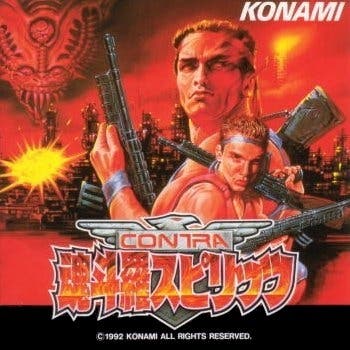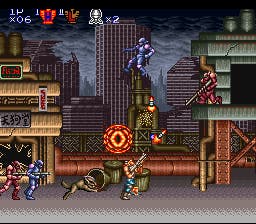Contra 3 retrospective
Hard corps.
Good video games can tell you a story, or transport you to another place. The very best ones, though, are a stage on which to perform. Maybe it's via the thundering staccato of a well-played Makoto in Street Fighter, or in a waltz with the grey wolf Sif through the bleak ballroom of Dark Souls' Darkroot Garden. They grant you mechanics of expression, and they're flourished with little details designed only to embellish your dance; Street Fighter's taunts that allow you to showboat, or Dark Soul's gestures that gift you the prancing power of a well animated emote. A boss fight in From Software's masterpiece is made all that more gratifying when you step in with arms outstretched in cocky defiance before unsheathing your blade.
Contra 3's got one of the best ever player gestures, utterly powerless against the onslaught of bulletfire but completely irresistible to throw in whenever you think you can get away with it. Holding down both shoulder buttons has your hero face the screen, two hulking guns raised to the skies in a pose ripped straight from the cover of every VHS you've ever glanced over in the action section of a local video rental store. It's a springboard for a somersault move that turns you into a Catherine wheel of brute force, but it's much more than that: it's a statement of intent, a cheeky aside as brilliant as any Arnie one-liner. Welcome to the gun show, it says: I'm here, and I mean some serious business.

Contra 3 means serious business, too. The fourth entry in a series that started with Konami's 1987 original, it was the first to be developed exclusively for a home console, and it came at a time when home hardware was beginning to step in time with the brutes of the arcades. Contra 3 looks as exquisite today as it did when it arrived with the first wave of SNES games in 1992, and at a time when the term arcade perfect was something to strive for Konami's engineers took the muscular template of the run and gun series and elevated it to a new level.
It's a flashy game, and sometimes it lets its desire to impress get in the way of its thrills: when a plane soars towards the screen, dropping a payload that turns the opening level into a hellish inferno where globs of flame dance dangerously into the night air, it's an impressive sight enabled by the hardware: the following level, one of a handful of overhead, Mode 7-fuelled open-ended scouting sections that pads out the slim run-time of Contra 3, is an example of the flashiness obscuring the design, an unwelcome diversion into sloppy hit-points and cheap deaths.
They're easily forgiven, though, because the rest of Contra 3 is exemplary, and while it's debatable whether it's the best exponent of its chosen genre, it's certainly one of the more polished, and perhaps the most varied. Jetbikes segue into missile rides and tower assaults, while monstrous tanks offer themselves up to be piloted in brief cameos - Contra 3 fills its short running time with countless ideas that are rarely repeated. That all comes together in Contra 3's deservedly iconic boss fight with Big Faust, a show-stopping encounter that revels in wrong-footing you. It starts with two bionic beasts bounding around a room until you manage to tear their torsos off - once you're done seeing them off, you'll breathe a small sight of relief before the wall's ripped apart and the true boss arrives. It's 16-bit stage direction at its finest.
There's a reference in the disembodied torso that tears its way towards you to James Cameron's original Terminator, of course, and Contra's a series fluent in the brilliant starch of 80s action. Jimbo and Sully, the two playable leads, might be descendants of Bill and Lance from the 1987 game, but they're also taking on the mantle of Stallone and Schwarzenegger, or of Willis and Seagal. Playing Contra 3 now feels like listening to a fast-talking twelve-year old who's been up all night scouring through a collection of classics of the era, as set-pieces are half-remembered and mangled together in a barely coherent train of thought.

Jimbo and Sully have their own descendants, too, in the likes of Marcus Fenix and the Master Chief. It's hard not to see some of the destroyed beauty of Contra 3's Neon City wearing off on the Sera of Gears of War, and there's a breathless rhythm to the play that's been studied by countless blockbusters since. The idea of two weapon slots introduced in Contra 3 would be resurrected by Bungie nearly a decade later, and the economy of Konami's design still feels like a template that's worth serious study.
Its legacy has wavered ever since, though. Two coders, Hideyuki 'NAMI' Suganami and Mitsuru 'Yaiman' Yaida, would meet for the first time while working on Contra 3, and shortly afterwards they left Konami to lend their talents to the then newly founded studio Treasure. Its debut game Gunstar Heroes took the action of Contra 3 and refined it even further, while Alien Soldier boiled it down into a mad, heady mix of boss fights and hyperactive gunplay that felt, in many ways, like a full stop for the genre. In the years since, Konami has struggled to equal the adrenaline burst of Contra 3, even if it has come close: 3D re-imaginings fell wide of the mark, and it's only Arc Systems' Hard Corps that's felt like it's had the conviction to be up to the task.
Rumours persist of a reboot in the vein of Mercury Steam's excellent revival of Castlevania, but in truth it feels like Contra's time has passed. It's still worth returning to, though, and its release on the Wii U's Virtual Console this week is the perfect excuse to go back, as well as an opportunity to play in 60Hz and without the strange edits of the European release of the original. Over 20 years on, the magic is intact - and Contra 3's still capable of a performance worth savouring.

